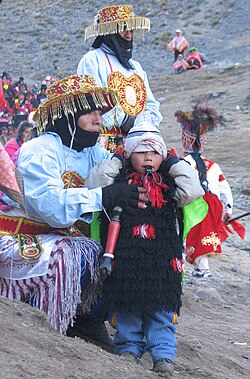 Participants at the Quyllur Rit'i festival. A ch'unchu performer can be seen in the background. | |
| Etymology | from Quechua Ch'unchu |
|---|---|
| Origin | Paucartambo, Cusco, Peru |
Ch'unchu is a folk dance in Peru. It is performed on festivals of the Cusco Region like Mamacha Carmen in Paucartambo and Quyllur Rit'i. [1] Varieties include q'ara ch'unchu, qhapaq ch'unchu [2] and wayri ch'unchu. [3] Its name comes from a derogatory Quechua word (also used in Aymara) for native inhabitants of the Amazon Rainforest. [3] [2] [4]